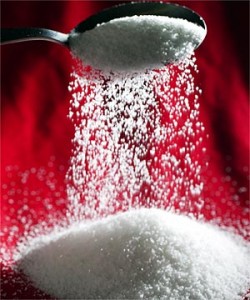Ahh yes, it’s ragweed and hay fever season again.
Every year, it hits me a ton of bricks. I wake up one morning and find I’m in a sleepy fog, my energy is gone, and my head is full, my eyes are irritated and itchy, and I’m sneezing and wheezing. This spring and early summer, we had more than the usual amount of rain, so I’m guessing the ragweed crop is especially bountiful. Oh joy.
About 1 out of 5 of us are allergic to ragweed in some form or another.
And with over 17 species of ragweed out there, that’s plenty out there to cause allergic reactions.
While some of you may head to your local Walgreen’s to load up on antihistamines, decongestants, and Kleenex, I usually start first with my diet.
While I eat a primarily Paleo style diet year ‘round, I find that really sticking to it during allergy season makes a huge difference in my allergic symptoms and how I feel.
There is a way to get some major relief from seasonal allergies with a Paleo style diet. Yep, that’s right. Diet can really make a BIG difference.
Take a close look at your diet. What you ARE eating and NOT eating has a big effect on the how your body reacts to other allergenic substances.
The thinking here is to avoid foods that cause inflammation—even if those foods do not directly cause an allergy.
I found out that totally eliminating grains from my diet, almost totally eliminated my allergy symptoms as well. And it’s not a gradual thing, but almost overnight, allergy symptoms will improve. While I’m not exactly sure why, I have a strong suspicion that it’s linked to the fact that grains cause inflammation, and inflammation is what makes allergies symptomatic.
Cutting out refined, processed foods that contain lots of sugar, chemically altered saturated fats (hydrogenated oils), and omega 6 (vegetable) oils will help your body's inflammatory load.
This includes anything with white flour, high fructose corn syrup, and chemical preservatives. So forego the cookies and candy for now.
And as much as I hate to say, if you drink, it’s best to eliminate alcohol for now, too.
Both red and white wine contain sulfites and histamines that can really make allergy symptoms worsen. And beer is made from grains and yeast, which is often also a problem—at least during allergy season. Ciders can have these same issues as well.
And you will want to avoid foods that are related to the pollen producing plants. Here’s a tip from one of my favorite health and nutrition bloggers, Mark Sisson:
“If you know the source of your particular allergy,[i.e., ragweed, tree pollen, etc] you can further pinpoint foods that tend to trigger what’s called “oral allergy syndrome,” a reaction to allergen-related foods that affects primarily the lips and mouth. Check out the Children’s Hospital of Philadelphia information on cross-reactive foods for those with seasonal allergies.”
For instance, if you have a problem with ragweed, you may also want to avoid bananas and cantelope during hayfever season.
Avoid pasteurized, conventional dairy products as much as possible during allergy season as well. You can be sensitive to pasteurized dairy, and not realize it, but it definitely can increase mucous secretions, and contribute to sinus problems.
If you MUST have dairy, find grass fed dairy, especially the raw, unpasteurized kind.
Grass fed dairy is rich in CLA, which is short for conjugated linoleic acid. Among CLA's many benefits is that it strengthens the immune system and lowers allergy reactions. And, grass-fed has about five times the amount found in the conventional dairy products.
Load up on antioxidant plant pigments—like the ones found in berries, peppers, red onions, and other britghtly colored fruits and veggies, to strengthen your mucous membranes and stabilize your immune cells. And these foods contains particiular nutrients like vitamin C and quercetin that are very powerful natural antihistamines.
Dark green leafy veggies like salad greens, parsley, kale, and spinach also contain magnesium, which can help breathing and stop the wheezing.
And speaking of avoiding inflammation, increase your EFA's.
Essential fatty acids are known and proven to fight inflammation. The EPA and DHA in wild caught fish, fish oils and grass fed meat is one of the best preventative measures you can take for allergy problems.
Tea, especially green tea, red tea, and white tea contain a flavonoid that not only reduces inflammation for offers support for the immune system. And regular black tea isn’t too bad either.
And there is some buzz on eating local honey, but I am not convinced. Because the bees get their pollen from nearby plants and flowers, the honey can be kind of like an allergy shot. Start with a little bit (a half teaspoonful or so) and work your way up to see if it helps.
Some other quick fixes can be implemented right away to bring about some immediate relief.
- First and most obvious is to close the windows in your home. Yeah, we’ve had our share of hot, humid weather and most of us are into full-on AC, but don’t get excited over that first cool day and open everything back up again. The pollen is still out there.
- Lots of folks just swear by a neti pot to rinse out the nose and sinuses daily. Neti pots can be found in most natural foods stores. To the uninitiated, it sounds a little crazy, but it can actually be a soothing and cleansing way to clear out the sinuses and help you breathe easier. Basically, it involves using purified water, a touch of sea salt and rinsing the salt water through the nasal passages. Once they try it, most people find Neti to be a soothing and pleasant experience. I guess it’s time for me to dig mine out and start using it again too.
Beyond that, I recommend a couple other nutritional supplements that work as well as or better (without the side effects) as pharmaceutical drugs:
- Vitamin C- Taking 2000 to 5000 mg a day will act like a natural antihistamine in addition to its other immune strengthening benefits. Build up your dosage gradually as larger doses of vitamin C can cause diarrhea.
- Freeze dried stinging nettle capsules cut down on the itching, and sneezing of allergies as well. Stinging nettle is thought to be as good as, or better than antihistamine hay fever medications. The dose used is usually two 300 mg capsules taken whenever the symptoms were experienced.
I have to tell you, I have tried all sorts of allergy remedies.
From over the counter medications, to the newest and latest prescription allergy medications, inhalers and nasal sprays, I've tried them. I even went through the whole process of allergy shots twice a week for several years. None of those things worked worth a darn, until I changed my diet.
Now, my allergy problems are virtually non-existant.
I may not stick with a Paleo style, no grain/no sugar diet 100% of the time, but when allergy season rolls around, I get back on the wagon, and feel great!
Give it a try. It works.
Till next time,
Stay healthy, lean and allergy free!
Don't forget to come over and visit, ask questions and interact with others on Facebook!
Catherine (Cat) Ebeling RN BSN, is a back to basics diet and nutrition specialist. In addition to her advanced degree in nursing from a major medical school, she has spent the last 30 years intensely studying diet, health and nutrition. She also has a book titled "The Fat Burning Kitchen, Your 24 Hour Diet Transformation" that has sold over 60,000 copies worldwide, and has helped thousands of people transform their lives, lose weight and improve their health.
Her mission is to help others prevent disease and live their best life ever.
Nutrition made Easy. Simple.Smart.Nutrition.







